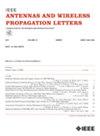Cosecant Squared Beamforming by Metasurface With Complex-Amplitude Controls for Antenna Array
IF 3.7
2区 计算机科学
Q2 ENGINEERING, ELECTRICAL & ELECTRONIC
引用次数: 0
Abstract
The antenna array loaded with complex-amplitude metasurface (MS) is reported to realize a cosecant squared beam. A novel MS unit-cell is proposed to independently manipulate the amplitude and phase of the transmissive linearly polarized electromagnetic wave simultaneously. The unit-cell consists of two metallic patterned layers printed on both sides of a substrate, and it has a profile height of only 2 mm (about 0.07λ). Further, it can achieve amplitude modulation from 0.2 to 1.0 with almost constant phase by rotating the metallic patterns, and phase modulation covers 360° by adjusting the radius of the patterns. In addition, a novel method for forming the cosecant squared beam based on the MS has been proposed. The transmissive amplitude and phase distributions of the MS are calculated to match the designed goals obtained by the genetic algorithm (GA), and a cosecant squared beam can be generated by loading the proposed MS on the antenna array. The proposed method is numerically and experimentally verified by a 10-unit line array loaded with the proposed MS, and the maximum gain of the antenna at 10.5 GHz is 11.9 dBi (about 16.4% aperture efficiency). The antenna can also achieve sidelobe level (SLL) lower −14.5 dB at 10.5 GHz with cross polarization below −7.2 dB. The cosecant squared patterns can be efficiently generated over a wide bandwidth from 10.1 GHz to 10.8 GHz (about 6.7%).求助全文
约1分钟内获得全文
求助全文
来源期刊
CiteScore
8.00
自引率
9.50%
发文量
529
审稿时长
1.0 months
期刊介绍:
IEEE Antennas and Wireless Propagation Letters (AWP Letters) is devoted to the rapid electronic publication of short manuscripts in the technical areas of Antennas and Wireless Propagation. These are areas of competence for the IEEE Antennas and Propagation Society (AP-S). AWPL aims to be one of the "fastest" journals among IEEE publications. This means that for papers that are eventually accepted, it is intended that an author may expect his or her paper to appear in IEEE Xplore, on average, around two months after submission.

 求助内容:
求助内容: 应助结果提醒方式:
应助结果提醒方式:


